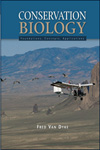 |  Conservation Biology: Foundations, Concepts, Applications Fred Van Dyke
Feature SummaryApproachConservation Biology: Foundations, Concepts, Applications reviews current efforts to preserve genetic diversity, populations, habitats, and ecosystems throughout the world. The author presents the discipline of conservation biology within an interrelated context of facts, theories, and values that define and motivate modern conservation initiatives, not as a collection of detailed and disjointed disciplinary expertise. This new textbook not only provides an up-to-date review of the scientific literature on conservation research and management, but also presents an interdisciplinary, in-depth examination of conservation's legal, ethical, and economic dimensions. Information on the origins of modern conservation biology and the historical development of its most important ideas is also included. The author reviews and critiques modern conservation strategies, and offers a thorough discussion of current conservation controversies. Because conservation biology is mission driven, it depends upon normative values to identify its research objectives and to set management priorities. Thus, the author explores the outcomes of different value positions and shows how various stands on controversial issues lead to radically different outcomes in conservation understanding and practice. Unique Chapter
Chapter 13, "Professional Effectiveness and Future Directions in Conservation Biology,"
is truly unique among textbooks for conservation biology. No other text offers objective criteria for selecting educational programs, mentors, and employment opportunities. Also discussed are emerging trends in conservation biology and their significance to the student—an appropriate way to end a cutting-edge textbook.OrganizationConservation Biology: Foundations, Concepts, Applications is organized around three fundamental questions:
1) How did conservation biology become a distinct discipline, and what keeps conservation biology from being absorbed into related disciplines? (Foundations)
2) What are the fundamental intellectual, conceptual, and practical problems that conservation biologists must address and solve? (Concepts)
3) What is the role of conservation biology in achieving “success” in conservation in ways that affect all dimensions of the human experience? (Applications) Pedagogy 1) Each chapter has a question or related group of questions, boxed in inserts labeled "Points of Engagement." These questions raise issues and problems about the material read thus far, and encourage students to reflect upon, or discuss concepts and their implications before proceeding further.
2) At the end of each chapter there are four groups of questions arranged to facilitate "Directed Discussions" about assigned readings from peer-reviewed journals. These differ from the usual "Questions for Discussion" that appear at the ends of chapters in most textbooks because each question leads logically to the next, and students must spend time reading scientific literature to see how ideas were initially presented.
3) Each chapter opens with a thoughtful Quote and a list of Learning Objectives, written in such a way as to encourage active learning and critical evaluation.
4) Important Key Terms are highlighted to signify definitions and help students review chapter material. These key terms are also defined in the end-of-book Glossary.
5) Finally, a comprehensive list of Literature Cited concludes each chapter and offers the student a bibliography on which to depend for research or further reading.
6) At the end of each chapter there is a list of Web Resources that relate to and enrich the material just covered. This list is repeated as hot links on the book's accompanying website. The website also offers test questions, images and animations to use in classroom presentations, links to professional organizations, articles on world ecological and environmental issues, and regional case studies. |
|



 2003 McGraw-Hill Higher Education
2003 McGraw-Hill Higher Education